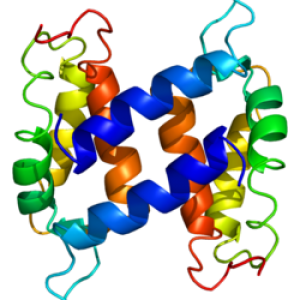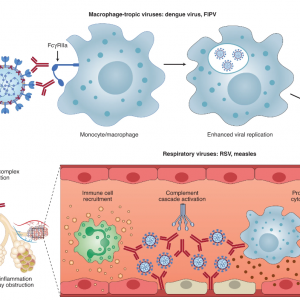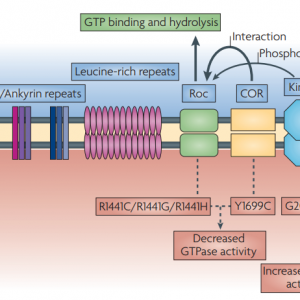Binding proteins are proteins that function in interaction with other (non-polypeptide) chemical groups attached by covalent bonding or weak interactions. According to the different non-polypeptide parts, they are divided into nuclear protein, glycoprotein, lipoprotein, phosphoprotein, metalloprotein and chromoprotein.
Glycoproteins are proteins covalently bound to carbohydrates and contain less than 4% sugar. In most cases, sugar content is less than protein. Glycoproteins are very complex proteins. In glycoproteins, sugar composition is often more complex, including mannose, galactose, fucose, glucosamine, galactosamine, sialic acid and so on.
Lipoprotein is a binding protein composed of protein and fat or lipids. Lipoproteins are ubiquitous in animals. Lipoproteins in the blood of higher animals include alpha-lipoprotein and beta-lipoprotein. Lipoproteins in the cell membrane affect the permeability of cell membrane.
Nucleoprotein is a protein binding to nucleic acids, including DNA nucleoprotein, ribosome, simple plant virus and so on. Nucleoprotein is found in all living organisms. Both cytoplasm and nucleus contain nucleoprotein.
Phosphoprotein is a protein covalently bound to phosphoric acid. Phosphoric acid binds to the side-chain hydroxyl groups of serine or threonine of proteins and has dissociatable acidic groups, which are mainly found in egg yolks and milk.
Protein Phosphorylation
Protein phosphorylation is a post-translational modification of proteins in which an amino acid residue is phosphorylated by a protein kinase by the addition of a covalently bound phosphate group. Phosphorylation alters the structural conformation of a protein, causing it to become activated, deactivated, or modifying its function. Human proteomes contain more than 100,000 potential phosphorylation sites. Most of the phosphorylated proteins contain more than one phosphorylation site, and exist in a mixture of different phosphorylation forms, which play an important role in the regulation of intracellular activity. The most commonly phosphorylated amino acids are serine, threonine, and tyrosine in eukaryotes, and histidine in prokaryotes and plants, which play important and well-characterized roles in signaling pathways and metabolism.
Protein phosphorylation is the most basic, universal and important mechanism to regulate and control protein activity and function. Phosphorylation of proteins is mainly concentrated on tyrosine, serine and threonine residues in the peptide chain. These residues have free hydroxyl groups and are not charged by themselves. When phosphorylated, proteins have charges, which lead to structural changes and further changes in protein activity. The main function of serine phosphorylation is to activate protein activity, mainly referring to enzyme activity. In addition to activating the protein's activity, tyrosine phosphorylation provides a structural gene for binding proteins to interact with other proteins to form a multiprotein complex.
Example of pSer/pThr-binding Proteins
The 14-3-3 proteins are phospho-serine/phospho-threonine binding proteins that interact with a diverse array of binding partners. The highly conserved 14-3-3 protein family has risen to a position of importance in cell biology owing to its involvement in vital cellular processes, such as metabolism, protein trafficking, signal transduction, apoptosis and cell-cycle regulation. Many 14-3-3 interactions are phosphorylation-dependent, and14-3-3 has been tightly integrated into the core phospho-regulatory pathways that are crucial for normal growth and development and that often become dysregulated in human disease states such as cancer.
14-3-3 proteins are highly conserved and seven family members are found in mammals – β, γ, ε, σ, ζ, τ and η. 14-3-3 dimers can interact with a diverse array of cellular proteins including transcription factors, biosynthetic enzymes, cytoskeletal proteins, signaling molecules, apoptosis factors and tumor suppressors. 14-3-3 proteins are able to interact with many different proteins as a result of their specific phospho-serine/phospho-threonine binding activity.
| Protein | Description |
| 14-3-3 beta | 14-3-3 beta is a protein that in humans is encoded by the YWHAB gene. It can interact with a variety of proteins, and is related to the pathological process of nervous system diseases and abnormal glucose and lipid metabolism in non-alcoholic fatty liver and other liver diseases. |
| 14-3-3 epsilon | 14-3-3 epsilon is a protein that in humans is encoded by the YWHAE gene. It interacts with CDC25 phosphatases, RAF1 and IRS1 proteins, suggesting its role in diverse biochemical activities related to signal transduction, such as cell division and regulation of insulin sensitivity. |
| 14-3-3 gamma | 14-3-3 gamma is a protein that in humans is encoded by the YWHAG gene. It is induced by growth factors in human vascular smooth muscle cells, and is also highly expressed in skeletal and heart muscles, suggesting an important role for this protein in muscle tissue. |
| 14-3-3 eta | 14-3-3 eta is a protein that in humans is encoded by the YWHAH gene. This gene contains a 7 bp repeat sequence in its 5' UTR, and changes in the number of this repeat have been associated with early-onset schizophrenia. |
| 14-3-3 theta | 14-3-3 theta is a protein that in humans is encoded by the YWHAQ gene. This gene is upregulated in patients with amyotrophic lateral sclerosis. |
| 14-3-3 zeta | 14-3-3 zeta(14-3-3ζ) is a protein that in humans is encoded by the YWHAZ gene on chromosome 8. 14-3-3ζ is a major regulator of apoptotic pathways critical to cell survival and plays a key role in a number of cancers and neurodegenerative diseases. |
| 14-3-3 sigma | 14-3-3 sigma(14-3-3σ) is a protein encoded by the SFN gene in humans. The protein is named for its presence in stratified epithelial cells. |
Cellular Functions
Protein phosphorylation, as the core of eukaryotic signal transduction, plays an important role in the life system. Serine phosphorylation is the most common form of phosphorylation in eukaryotes, followed by threonine phosphorylation. Phosphorylation of serine, threonine and tyrosine residues is a very important regulator of protein function. Phosphoprotein is important for cells.
The 14-3-3 proteins are involved and appear to regulate a wide range of cellular processes including metabolism, stress and nutritional-deprivation responses, development and cell differentiation, migration, cell division, DNA damage responses, receptor recycling and trafficking, protein degradation, and programmed cell death. 14-3-3 proteins can interact with important molecules in signal transduction, regulate their activity or change their subcellular localization, which is an important regulator in signal transduction. In addition, 14-3-3 protein is closely related to the survival of cells, which can inhibit cell apoptosis and promote cell survival. One way that 14-3-3 influences the balance between survival and apoptotic signaling is by antagonizing the activity of proteins that promote cell death and senescence. The 14-3-3 protein also binds to the beta subunit of the phosphorylated H+-ATPase, inhibits the activity of the H+-ATPase, and participates in metabolic activities.
Role in Disease
Recent studies have clearly demonstrated the involvement of 14-3-3 proteins in cellular processes that directly impact tumor development, such as cytokinesis, cell-contact inhibition, anchorage-independent growth and cell adhesion.
14-3-3 protein was first found in the brain and was expressed in large quantities in the brain. This indicates that 14-3-3 protein plays an important role in the brain. In the study of Parkinson's disease (PD) and Alzheimer's disease (AD), 14-3-3 protein was also found to be involved in the formation of these two diseases.
14-3-3 protein has been closely concerned by people as a treatment for diseases. At present, the research on 14-3-3 protein as a target of disease treatment focuses on the following aspects. The first is to develop specific inhibitors of 14-3-3 protein. Another strategy is to inhibit the activity of some phosphorylated kinases. Because the binding site of 14-3-3 protein is often phosphorylated, inhibition of phosphokinase can prevent 14-3-3 protein from binding to its ligand, thus achieving the purpose of disease treatment.
References:
- Aitken A. 14-3-3 proteins: a historic overview. Semin Cancer Biol. 2006, 16:162–172.
- Gardino AK, et al. Structural determinants of 14-3-3 binding specificities and regulation of subcellular localization of 14-3-3-ligand complexes: a comparison of the X-ray crystal structures of all human 14-3-3 isoforms. Semin Cancer Biol. 2006,16: 173–182.
- Cohen, Philip. The origins of protein phosphorylation. Nature Cell Biology. 2002, 4 (5): E127–130.
- Cozzone AJ. Protein phosphorylation in prokaryotes. Annu. Rev. Microbiol. 1988, 42: 97–125.





